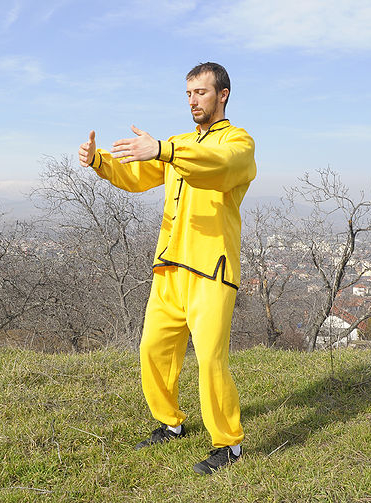

Tai Chi and Meditation
Tai chi is a relaxing and calming form of exercise which allows the mind to let go of yesterday, stop fretting about tomorrow and concentrate on today, better than that it allows the mind and body to live in the current moment. This state of mindfulness is sought in many other forms of exercise, like Yoga, Pilates, Buddhist meditation.
Tai chi is also known as a 'moving meditation', where the mind, body and spirit are brought into harmony and a state of relaxation by focusing on the movement and the intent of the moves in the form. The Yang style form (sequence of movements) is slow and gentle, but requires concentration to maintain the smooth grace of the body. This focusing on the now brings about a state of mindfulness, which in turn relaxes the body and mind.
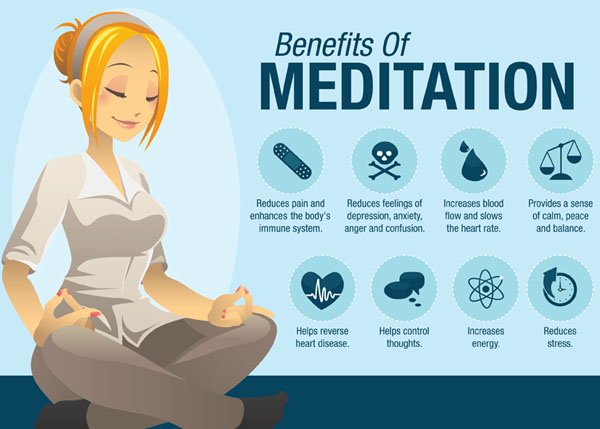
from http://wondergressive.com
There are forms of meditation in Tai Chi which involves sitting or standing and calming the mind into quietness, not allowing stray thoughts to cause tension and distraction, Taoists have been using meditation to clear the mind and induce a state of peace and harmony which can aid the body's ability to heal itself. The connection to the ground and a floating sense of self, creates a stillness of mind and body.
Standing meditation
The most basic form of meditation is a standing meditation, which involves having a strong link with the ground and a feeling of weightlessness at the top of the head which lifts the mind into a quiet place, sound a bit mystical I know, but a strong straight posture with relaxation of the joints and muscles is what I am trying to get across. This is the basis of the technique:
- First stand with your feet shoulder-width apart with your toes pointing straight ahead and your knees slightly bent (by bent I mean softened and relaxed).
- With your hips tucked slightly forward (this is a slight rolling of the hips under the spine to create a lovely flat base of the spine), tuck the chin down slightly to lengthen the top of the spine, keep your shoulders down and relaxed and your head held up (as if being pulled up by a piece of string attached to the top of the head, this lengthens and straightens the top of the spine).
- Slowly inhale and exhale deep breaths through your nose. You should breathe deeply as if you are breathing into your pelvis, using the strong muscles at the base of the ribs called the diaphragm and then using the muscles to help push the used air out. This is called Diaphragmatic breathing. Continue this meditation technique by keeping your eyes closed or slightly parted, and begin meditating (try focusing on the journey of each breath into the lungs - inhale and out of the mouth - exhale).
- You can also focus on your feet and their connection to the earth.
- You can also imaging that as you inhale, that you are pulling energy into your feet from the ground or earth. As you exhale, you return the energy to the ground. By combing following the breath and following the ground energy you can achieve a lovely state of calm and 'emptiness'.... but, start with following the breath only until you get used to switching off the 'monkey brain'.
- Repeat this breathing meditation for increasing lengths of time, and feel the centre of your body or dantien, which is located just below your belly button. Exhale, ridding your body of any unclean energy.
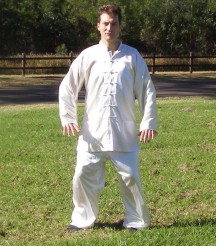
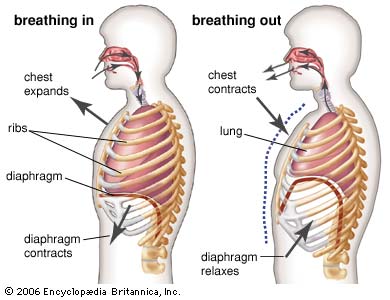
The breathing cycle
A seated version can be done, using all the same guidelines as the standing version, tech feet are flat on the floor and the back should be supported. A more advanced version can be done sitting forwards on tech chair and maintaining a straight posture unsupported. As with the standing version, concentrate on the journey of the breath and acknowledge but do not engage with random thoughts that may appear in your mind.
It is like watching a stick (the thought) floating towards you when you are standing on a bridge over a stream, simply watch the stick pass under the bridge and float away downstream without engaging with the stick. It is OK to acknowledge the thought, but do not allow it to take hold, a difficult process but worthwhile when you achieve the state of calmness and clarity.
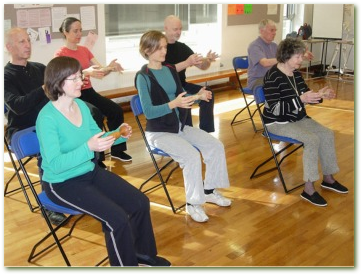
Standing Pile Stance
Body position
This meditation can be done in what is called a Horse Stance. The feet are wider than shoulder width, the hips are gently tucked under the spine, the body sits straight downwards with the spine kept vertical and straight. The chin is gently tucked towards the chest and you feel tall as if pulled by a piece of string attached to the top of the head. This ensures the spine is held in the best possible position. The head rests at the top of the spine, balanced perfectly with tech weight supported by the straight spine.
Arms Position
With your arms raised in front of the chest, forming a circle at chest height with elbows relaxed and forming a circle with the arms. It is as if the elbows are floating up and filled with helium, this is called the 'Pile Stance' also called the 'Horse Stance' and is like hugging a tree with the palms facing your chest. Try this for a couple of minutes to start and gradually increase the time up to 10 minutes. This pose can be held for much longer times when your stamina is has increased and your meditation becomes easier.
Word of caution
If you have heart or blood pressure problems this pose can be don with the palms turned down and facing the floor. This will help to lower blood pressure.
If your legs feel tight or heavy at the end of this exercise, place your hands on the lower back, Push out the toes of one foot to the front, then lift the knee and step back to place your floor flat on the ground. Lift the second leg, push the toes out to the front, lift the knee and step back to place your foot back on the ground. This will help out out the toxins that build up in muscles and allow fresh blood to flow through the muscles relaxing them and taking away the heavy feeling.
When doing exercise which activates muscle groups, be sure to drink water regularly for 24 to 48 hours in order to help flush out the toxins through the kidneys and bladder. If you don't do this, you may feel a bit rough, under the weather, tired or even slightly ill, until the toxins are removed from the body. So, drink, drink, drink; water is always the best thing to drink.
